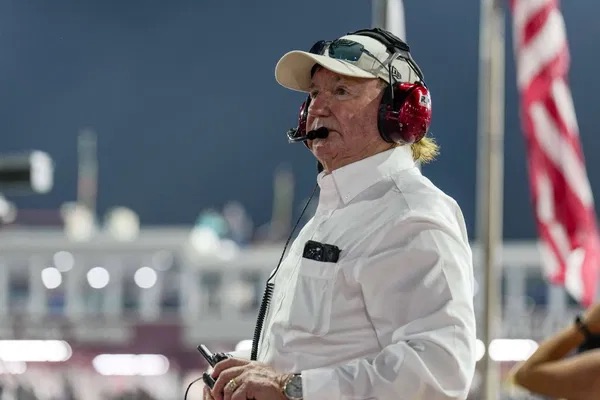On Saturday night, Jesse Love had every reason to be happy. He powered his No. 2 Richard Childress Racing Chevrolet through two red flags, 14 cautions, and a chaotic overtime finale to cross the finish line first at Rockingham Speedway under the lights. The crowd roared. After over two decades, the track was back on the Xfinity Series schedule, and Love was the one who made history. The 20-year-old Californian, who is already widely regarded as RCR’s emerging star, gave a passionate victory speech, pumped his fists to the applauding audience, and slid out the roof hatch. “What a fantastic racetrack. I doubt you can hear me at this moment. This racetrack is just what I’m looking for. It’s hammer down,” he uttered almost shouting over the roaring fans. He dedicated the moment to his girlfriend’s sister Jessica, who died a year ago from skin cancer, and urged fans to get checked. The moment felt emotional, raw, and real.
However, NASCAR interrupted the festivities a few minutes later. During the post-race inspection, officials discovered a rear suspension issue and disqualified Love’s vehicle. He lost the victory and fell to 37th place. The growing celebrity of Richard Childress abruptly stood on the sidelines, observing another person get the trophy. As we await an appeal, a lot of supporters and insiders are now inquiring: Did Jesse Love lose a legitimate victory because of NASCAR?
What transpired and why is the rear suspension debate important?
What we know is as follows. The No. 2 vehicle was disqualified by NASCAR for violating rule 14.14.2.i-5.h. The majority of supporters are unaware of that rule, yet it was crucial in denying a victory. It focuses on the mating surfaces between the trailing arm of the vehicle and the U-bolt saddle on the car’s rear suspension. The rule says these parts must be in complete contact with each other at all times.
Although it may seem like a minor thing, it isn’t. A U-bolt holds the rear axle housing to the truck arm. It is deemed unlawful if the gap is even greater than 0.010 inches. In a post-race teardown, NASCAR verifies that measurement. Why is this important, then? because the rear suspension may have more flex if there is a small separation. Performance can be enhanced by such kind of elasticity, particularly in the way the vehicle manages loads and corners. According to others, Love’s crew may have purposefully undertightened the U-bolt to obtain that tiny flex, which can increase a car’s stability, efficiency, and speed. But NASCAR makes a clear distinction. According to the rulebook, parts must be tight and aligned no wiggle room. Xfinity Series director Eric Peterson made the ruling clear. “They need to be tight and touching each other the whole time. Unfortunately, that was not the case,” he said.
Now, given how messy, chaotic, and contact-heavy Rockingham was throughout the race, there’s always a potential that something shifted. Maybe a piece has moved. Richard Childress Racing should therefore be popular. They will make an argument if they think it was an accident or the result of damage. But for the time being, Love’s victory is no longer recorded. But the repercussions were severe. In addition to taking home the final $100,000 Dash 4 Cash incentive, Sammy Smith, a driver for JR Motorsports, was promoted from second to first. Even Smith acknowledged that Love’s #2 car was superior to his, saying, “The 2 car ultimately had the best car.” Those boys performed admirably. He knew who was the fastest, yet he still received the trophy. Love was now left with nothing. From a career-best moment to a technicality-induced collapse, it was a brutal swing. The question remains—was it intentional setup tweaking, or just bad luck in a brutal race? NASCAR’s rulebook doesn’t care about intent. It cares about precision.
Why is there criticism about NASCAR? Jesse Love’s heartbreak is not the first time NASCAR has lost a 2025 race, according to Parker Kligerman
Parker Kligerman was in a similar predicament only a few weeks prior. Kligerman won the Daytona season opening. Kligerman is a full-time Cup and Xfinity commentator and a part-time Truck Series driver. It was the “biggest win of my entire life,” he said. The moment was sheer ecstasy for the driver and his squad as fans cheered and he rejoiced in the infield grass. The post-race inspection followed. Kligerman’s truck was deemed by officials to be excessively low in the back on both sides. The panel maintained the penalty despite Henderson Motorsports’ appeal. Corey Heim was proclaimed the new winner after NASCAR revoked the victory. Similar to Jesse Love, Kligerman transitioned from first to forgotten in a matter of hours. There are parallels between the two situations. Both drivers crossed the finish line first and gave emotional speeches.
Due to setup bets or race conditions, both vehicles might have broken the rules a bit too much. And NASCAR remained steadfast in both situations. The crucial distinction? the type of infractions. The total ride height, which might change as a result of contact, wear, or injury, was Kligerman’s problem. A suspension assembly’s part-to-part contact that influences chassis flex was the subject of Jesse Love’s far more complex issue. However, the outcome remained the same. a win-lose situation. A revised tale. Fans find it difficult to accept. Many call for the elimination of NASCAR’s post-race inspection policy and wonder why it exists. It definitely detracts from the drivers’ and the team’s victory lane celebration.






